Missouri’s St. Louis Roots

Today marks the 191st anniversary of the first meeting of the Missouri general assembly:
“September 18, 1820:Â The first session of the general assembly of the state of Missouri met in the Missouri Hotel in St. Louis to administer the affairs of a state still awaiting statehood. In March jubilant St. Louisans had received news that the Missouri State Bill had passed Congress, and, despite the fact that debate over the Missouri Compromise caused a delay of more than a year in its ratification.” (St. Louis Day by Day p178)
Missouri became the 24th state in the Union on Aug. 10, 1821 (source). Missouri’s origins were in St. Louis:
The present Capitol, completed in 1917 and occupied the following year, is the third Capitol in Jefferson City and the sixth in Missouri history. The first seat of state government was housed in the Mansion House, Third and Vine Streets, St. Louis; the second was in the Missouri Hotel, Maine and Morgan Streets, also in St. Louis. St. Charles was designated as temporary capital of the state in 1821 and remained the seat of government until 1826. (Wikipedia)
The Missouri Hotel was razed in 1873. The poll question this week: “Missouri legislators are “part-time” public servants, should we have full-time legislators to manage the state?” The poll is in the right sidebar, final results on Wednesday September 28, 2011.
– Steve Patterson







